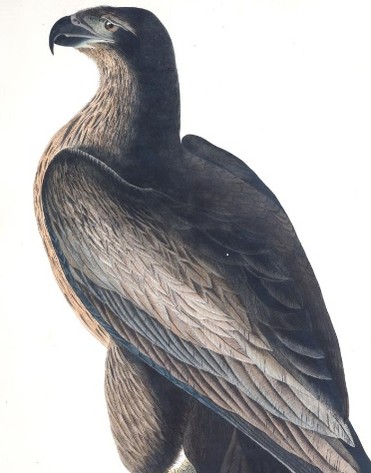‘The Indians Say’: Settler Colonialism and the Scientific Study of Animals in America, 1722 to 1860 By E. Bennett Jones (Northwestern University), Visiting Graduate Student Fellow at the Beinecke Library, July 2018
In 1828 famed artist and ornithologist John James Audubon published a description of the “eagle of Washington” (Falco washingtonii), a new bird species that he was the first to formally name. Despite Audubon’s fame and accomplishments, this discovery was met with controversy. Other leading naturalists questioned if the eagle of Washington truly existed, given that it was allegedly larger than the bald eagle and exceedingly rare. John Bachman, Audubon’s closest friend and scientific collaborator, assured Audubon in an 1837 letter that “I think pretty well established” the eagle of Washington was in fact a new species pointing to “Louis [sic] & Clark,” “the naturalists in the Long Expedition,” and “the Indians” as sources that corroborated Audubon’s claims.[1]
My dissertation, ‘The Indians Say’: Settler Colonialism and the Scientific Study of Animals in America, 1722 to 1860, examines the use of animal stories attributed to Native Americans by Euro-American naturalists like Audubon. I am interested in how these naturalists cited, interpreted, and valued information obtained from Native Americans as well as how they may have falsified and exaggerated these same sources. Despite the accepted use of anecdotal evidence within natural history during this period, naturalists often disagreed over what made a credible or accurate source. For naturalists living in the United States in the late eighteenth and early nineteenth centuries, information from Native Americans bolstered their claims to scientific authority and gave them a body of evidence their European colleagues could not access. The use of these “Indian” stories by American naturalists, however, was also tied to American settle colonial projects during this same period. By transcribing and adding interpretation to so-called Native American stories, Euro-American naturalists were also attempting to claim authority over indigenous people.
My project starts from the writing of well-known naturalists like Audubon and works backwards to locate their sources of “Indian” knowledge. The Beinecke Library has one the largest collections of Audubon materials, including his personal letters, manuscript drafts, and even a fragment of one of his journals. Going through these letters has introduced me to Audubon’s struggle to prove the eagle of Washington’s existence as well as some of his encounters with Shawnee and Osage hunters while out collecting bird specimens. These letters have also added a new element for my project to analyze: so-called “fish stories,” popular among hunters and woodsmen like Audubon. Audubon’s friends mentioned his propensity for telling “yarns” or tall-tales. Some letter writers also wrote in defense of their own stories, asking Audubon and Bachman not to dismiss their accounts as just another “fish story.”[2] These documents paint a picture of an American frontier culture where stories were swapped among outdoorsmen and exaggeration was common. What was the relationship between these “fish stories” and other kinds of anecdotes and how did these stories shape the writing of natural history? How did Native American hunters and guides participate in “fish story” swapping?
E. Bennett Jones is a doctoral candidate in history at Northwestern University specializing in early American history and the history of science. She earned her M.A. in Museology from the University of Florida and her B.F.A. in studio art from the School of the Art Institute of Chicago. Her current research examines the use of storytelling within natural history, focusing on animal stories as well as on collaboration between Euro-American naturalists and Native Americans.
***
The Beinecke Library encourages scholars, students, and the public to engage the past in the present for the future. In the service of new scholarship, the library offers generous fellowships for visiting scholars and for graduate students to support research in a wide range of fields. Learn more about fellowship opportunities.
[1] John Bachman to John James Audubon, 24 April 1837, Box 3, Folder 84, Morris Tyler Family Collection of John James Audubon. General Collection. Beinecke Rare Book and Manuscript Library.
[2] Joseph Moore to John James Audubon, 28 September 1842, Box 5, Folder 252, Morris Tyler Family Collection of John James Audubon. General Collection. Beinecke Rare Book and Manuscript Library.
